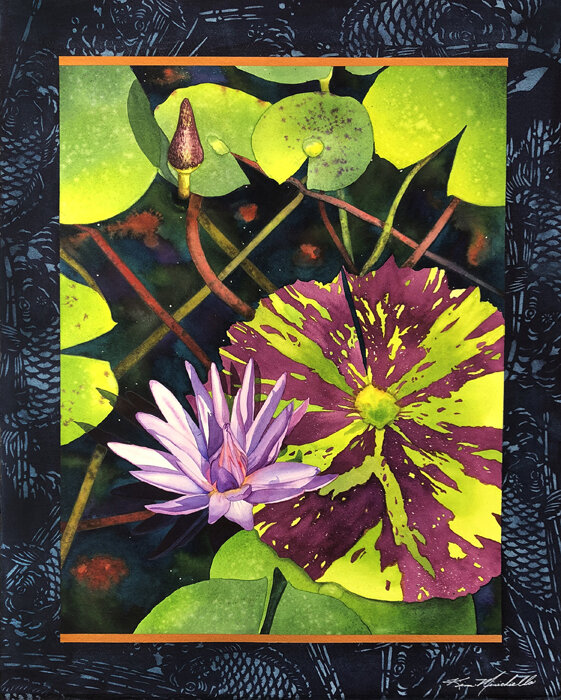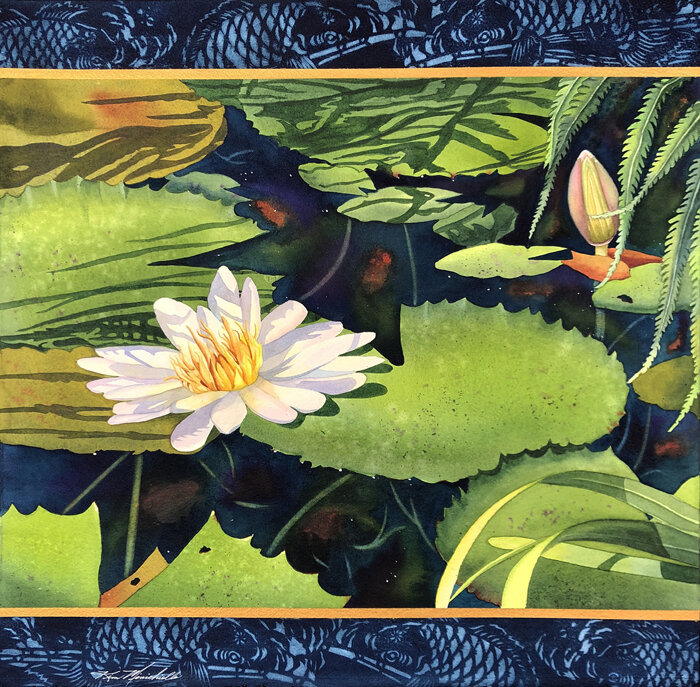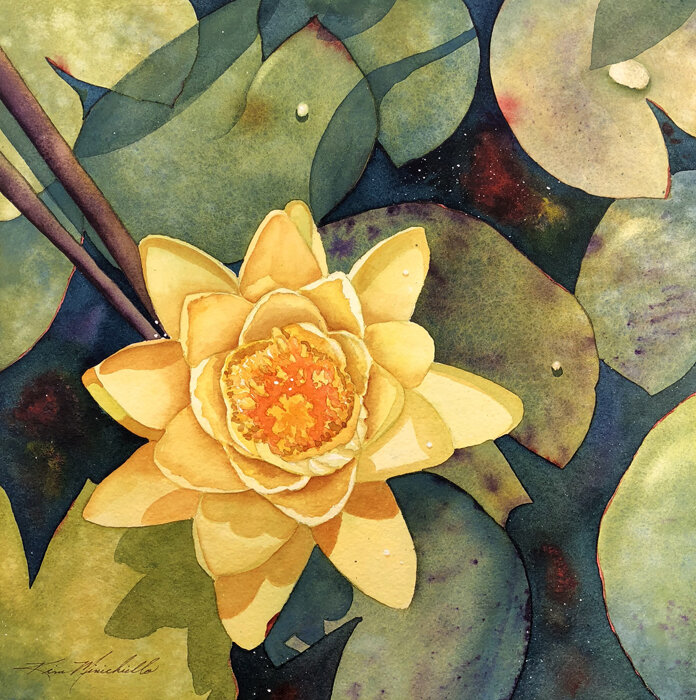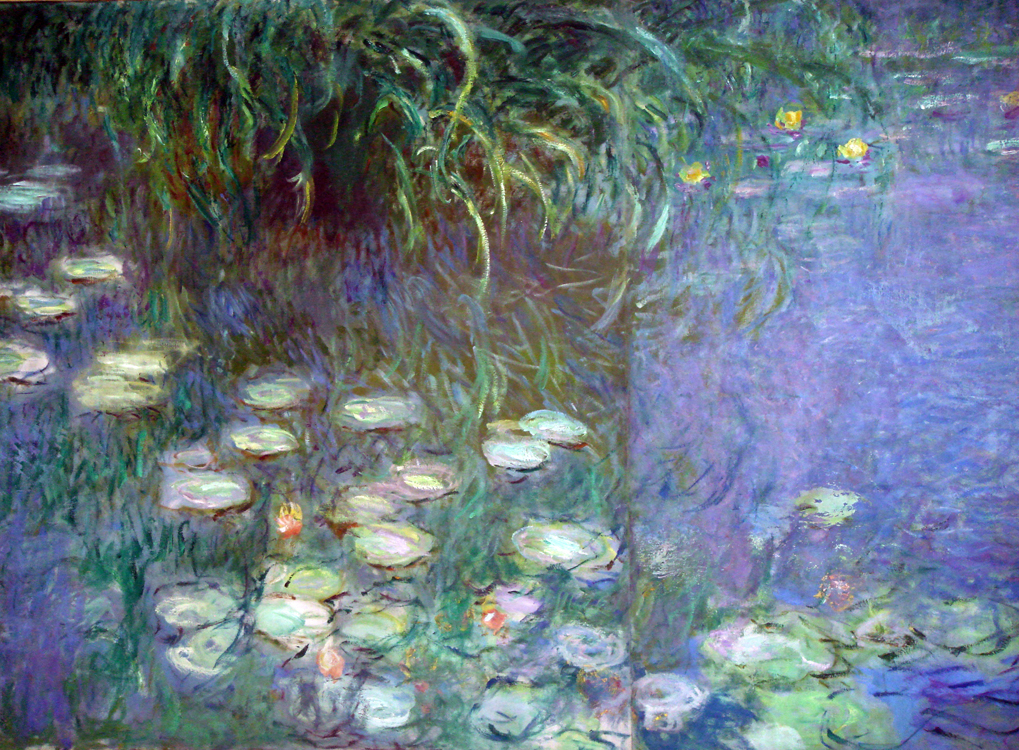A Calming Influence, 24” x 19,” Watercolor on Fabriano 300 lb. Cold Press
It has been a while since I have written an article on my blog! Who knew how much the world would change between then and now, and I feel there are more changes to come. My hope is that the world will be a kinder and more peaceful place. While I do not like the circumstances and the hardships that many are facing in this wild time, I do believe that sometimes there are good things that come from the bad, and I try to remind myself this to be more at peace. I’m trying to take more time to do things I enjoy, gardening, cooking, and enjoying nature. This time I’ve had at home during the COVID-19 quarantine has made me reflect how I may go forward in the future, and I am more grateful for each day I am alive and well.
In My Solitude, 20” x 20,” Watercolor on Arches 300 lb. Cold Press
One positive change is having so much dedicated time in the studio! I have been wanting to do a water lily series on a larger scale. Previously I have only painted them 12” x 12.” I felt it would be the perfect subject matter to paint during this quarantine time. I find them to be a calming influence. I finally started on them and I am currently working on the fourth in the series. I have at least five planned. Their titles reflect how I have been feeling during the lock down and how I felt painting them.
A Moment of Pause, 22” x 12,” Watercolor on Arches 300 lb. Cold Press
As I mentioned before, painting this subject matter larger is a change. I spend a lot of time designing each of my paintings, and love doing it. I make a lot of changes from my original photo references, mixing more than one photo together for the right composition. I re-work the positions of elements within the photo. I add elements that are needed for the composition, even if they didn’t exist in real life. I also change colors from my photo references, and recently I have enjoyed designing and incorporating borders as part of my body of work.
For this series, I ventured out into new paper territory. Most of my work is on Arches or Twin Rocker paper. ( Never heard of Twinrocker? You can read it about it here on a previous post. ) The first two in the series were painted on Arches 300 lb. cold press. On the third painting I decided to try Fabriano 300 lb. cold press.
Nocturne, 12” x 12,” Watercolor Mounted on Cradled Archival Board and Sealed
When you have a lot of time invested in designing and drawing it can be a risk to try something out of the norm. But if we don’t, how will we learn and grow? I bit the bullet and committed to completing the painting on the Fabriano paper. With my particular painting style it took me a while to get used to it until I realized what I normally do had to be done somewhat differently. As I got into the rhythm of it, I really enjoyed it. It was like going on a little vacation, which is as good as it’s going to get right now!
Interlude, 12” x 12,” Watercolor Mounted on Archival Cradled Board and Sealed
What was different, you might ask? First the paper is softer, you can tell just by how it feels. I was worried if I had to scrub out an area or lift, would it mutilate the paper too much, but I didn’t find it to be an issue. All paper companies have their “secret sauce” for sizing their paper. For example, some use animal byproducts in their sizing, I do know that Fabriano does not. That is why Arches can sometimes have that wet dog smell. (No, Arches does not use dog in their sizing, but I think there might be something from an animal in there.) I feel Fabriano might have less sizing then Arches. It could have been the weather that day, but I did feel washes tend to dry a bit quicker. However, working wet into wet, it was fine. Everything stayed wet long enough for me to get done what I needed to in a wash. I also use masking tape to mask areas I want to preserve the white of the paper and paint later. I was concerned with a softer paper the top surface of the paper would lift off with the tape, but it didn’t, and masking fluid came right off too.
Trio, 12” x 12,” Watercolor Mounted on Cradled Archival Board and Sealed
I also felt the color seemed to be more vivid on the Fabriano paper. The paper could be whiter or the sizing may have an effect on the appearance of the paint on top. Another factor could be how much paint soaks into the paper versus sitting on top of it. Whatever it is, I like the results. However, one thing that did take some getting used to was if I painted over an area twice after the first wash had dried, the paint underneath seemed to lift easier than on Arches. It took a natural hair brush and a light touch for the first wash not to mix with the second. That was probably my biggest work around for the way I paint.
If I were to say anything negative about Fabriano vs. Arches, it would be that their water mark goes all they way across the top of the short side of the paper. That doesn’t bother some people but if I were to do a painting on a full sheet you would see it as part of my painting. I’m not so keen on that. One work around is to use the opposite side. However, there is a different texture on each side of the paper. If you liked the texture on the water marked side and you wanted to do a painting on a full sheet, you are stuck with it. Arches’ watermark is more subtle. It is small and in a corner.
Meditation II, 12” x 12,” Watercolor Mounted on Archival Cradled Board and Sealed
Overall, I felt like the change was good! Would I use Fabriano again? Absolutely! Would I stop using Arches, not necessarily. I tend to use the paper I need for what I want to achieve in the painting because they all behave differently, just like our dear children or pets. That is why I also use Twinrocker paper and occasionally, when I have the opportunity, I buy other brands I would like to try too. I have tried some that will never make it into my repertoire, and like Fabriano some brands will have a place in my studio and potentially be used en plein air paintings as well!
Don’t be afraid of change. We certainly can’t have that attitude in this unprecedented time in human history. Take a risk, what are you going to do different today? Feel free to leave a comment. If you subscribe to my blog and are getting this via email, click on it to go to my web site and leave your comment there. :-)
Wishing you continued safety and good health!
Kim
Like this post and leave comments below if you have any questions or comments!


















